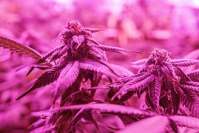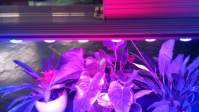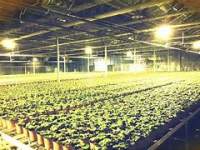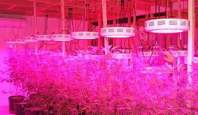Which led plant lights is more suitable for greenhouse crops?
When planting crops in large sheds, you must worry about the lighting of the plants. If the sun is insufficient, it will affect the growth and flowering of the crops. Therefore, people will think of using LED full-spectrum plant supplement light to supplement light for plants.
light sources that affect plant growth
Light is the basic environmental factor for plant growth and development. It is not only the basic energy source for photosynthesis, but also an important regulator of plant growth and development. The growth of plants is not only restricted by the amount of light or light intensity (photon flux density, photonfluxdensity, PFD), but also by light quality, that is, light and radiation of different wavelengths and their different composition ratios.
The solar spectrum can be roughly divided into ultraviolet radiation (ultraviolet, UV<400nm, including UV-A320~400nm; UV-B280~320nm; UV-C<280nm, 100~280nm), visible light or photosynthetically active radiation (photosynthetically active radiation, PAr , 400~700nm, including blue light 400~500nm; green light 500~600nm; red light 600~700nm) and infrared radiation (700~800nm). Due to the absorption of ozone in the stratosphere (stratosphere), uc-c and most of uv-b cannot reach the surface of the earth. The intensity of uv-b radiation reaching the ground changes due to geographic (altitude and latitude), time (day time, seasonal changes), meteorological (cloud layer, thickness, etc.) and other environmental factors such as atmospheric pollution. .
Plants perceive subtle changes in light quality, light intensity, duration and direction of light in the growing environment, and initiate changes in the physiological and morphological structures necessary for survival in this environment. Blue light, red light and far-red light play an extremely critical role in controlling the light morphogenesis of plants. The photoreceptors of phytochrome (Phy), cryptochrome (Cry) and photoreceptors (Phot) receive light signals and trigger plant growth and development changes through signal transduction.
The monochromatic light mentioned here refers to light in a specific range of wavelengths. The wavelength range of the same monochromatic light used by different experimental subjects is not completely the same, and it often overlaps with other monochromatic lights with similar wavelengths to different degrees, especially before the emergence of LED light sources with good monochromaticity. in this way. Naturally, different or even contradictory results will be produced.
Red light
Red light (R) inhibits internode elongation, promotes lateral branching and tillering, delays flower differentiation, and increases anthocyanins, chlorophyll and carotenoids. Red light can promote the positive light movement of Arabidopsis roots. Red light has a strong positive effect on the resistance of plants to biotic and abiotic stresses.
Far red light (FR) can counteract the red light effect in many cases. Low r/fr ratio leads to reduced photosynthetic capacity of kidney beans. In the growth room, white fluorescent lamps are used as the main light source, and LEDs are used to supplement far red radiation (emission peak 734nm) to reduce the content of anthocyanins, carotenoids and chlorophyll, and make the plant fresh weight, dry weight, stem length, leaf length and leaf length. Width increases. The effect of supplementing fr on growth may be due to the increase in light absorption caused by the increase in leaf area. Arabidopsis thaliana grown under low r/fr conditions has larger and thicker leaves, larger biomass, and strong cold adaptability than plants grown under high R/FR. Different ratios of R/FR can also change the salt resistance of plants.
Blu-ray
Generally speaking, increasing the share of blue light in white light can shorten internodes, reduce leaf area, reduce relative growth rate and increase nitrogen/carbon (n/c) ratio.
Blue light is needed for chlorophyll synthesis and chloroplast formation in higher plants, as well as sun chloroplasts with high chlorophyll a/b ratio and low carotenoid levels. Under the red light, the photosynthetic rate of the cells of the algae will gradually decrease, and the photosynthetic rate will quickly recover after turning to blue light or increasing some blue light under continuous red light. After dark-growing tobacco cells were transferred to continuous blue light for 3 days, the total amount and chlorophyll content increased sharply. Consistent with this, the dry weight of cells per unit volume of culture medium will also increase sharply, and will increase very slowly under continuous red light.
For the photosynthesis and growth and development of plants, red light alone is not enough. Wheat can complete its life cycle under a single red LED light source. To obtain very large plants and a large number of seeds, an appropriate amount of blue light must be added (Table 1). The yield of lettuce, spinach and radish grown under a single red light is lower than that of plants grown under a combination of red and blue light, while the yield of plants grown under a moderate amount of red and blue light is comparable to that of plants grown under a cool white fluorescent light. Similarly, Arabidopsis thaliana can produce seeds under a single red light. Compared with plants grown under a cool white fluorescent light, as the proportion of blue light decreases (10%~1%), plants grown under a combination of red and blue light Bolting, flowering and fruiting will be delayed. The seed yield of plants grown under a 10% combination of red and blue light is only half of that of plants grown under a cool white fluorescent lamp. Excessive blue light inhibits plant growth, shortens the internodes, reduces branches, reduces leaf area and reduces total dry weight. There are obvious species differences in the blue light needs of plants.
Although some studies with different types of light sources have shown that the differences in plant morphology and growth and development are related to the different proportions of blue light in the spectrum, the conclusions are still questionable because the composition of the non-blue light emitted by the different types of lamps is also different. Although the dry weight and net photosynthetic rate per unit leaf area of soybean and sorghum plants grown under the same intensity of fluorescent lamps are significantly higher than those of plants grown under low-pressure sodium lamps, these results cannot be attributed to the lack of blue light under low-pressure sodium lamps. I am afraid it is also related to too much yellow and green light and too little orange-red light under low-pressure sodium lamps.
Green light
The dry weight of tomato seedlings grown under white light (including red, blue and green light) was significantly lower than that of seedlings grown under red and blue light. The results of spectroscopic detection of growth inhibition in culture showed that green light is a harmful light quality with a peak at 550nm. The plant height, freshness, and dry weight of marigolds grown under light that removes the green light will increase by 30%-50% compared to plants grown under full-spectrum light. Full-spectrum light supplementing green light leads to short plants and reduced dry and fresh weight. Removal of green light enhances marigold blooming, while supplementation of green light inhibits the blooming of dianthus and lettuce.
There are also research reports on green light promoting plant growth. Kim et al. (2006) summarized the experimental results of red and blue combined light (LEDs) supplementing green light and concluded that plant growth is inhibited when green light exceeds 50%, and plant growth is enhanced when the proportion of green light is less than 24%. Although the addition of green light to the red and blue combination light background provided by the LED led to a significant increase in the lettuce ground stem, the conclusion that the addition of green light strengthens plant growth and produces more biomass than under cold white light is a problem : (1) The dry weight of biomass they observed is only the dry weight of the upper part of the ground. If the dry weight of the underground root system is included, the results may be different; (2) Lettuce grown under red, blue and green lights on the ground The dry weight of the part is larger than that of plants grown under cool white fluorescent lamps. It is likely that the three-color lamps contain much less green light (24%) than cool white fluorescent lamps (51%). That is to say, the green light inhibiting effect of cool white fluorescent lamps is greater than that of cold white fluorescent lamps. Three-color light; (3) The photosynthetic rate of plants grown under combined red and blue light is significantly higher than that of plants grown under green light. The results support the previous speculation.
The green light effect is usually the opposite of the red and blue light effects. Green light can reverse blue light and promote the opening of stomata. Treating the seeds with a green laser can quickly grow radishes and carrots to twice the size of the control. A dim pulse of green light can accelerate the elongation of seedlings growing in the dark, that is, promote the elongation of the stem. Treatment of Arabidopsis albino seedlings with a single green light (525nm±16 nm) pulse (11.1 μmol·m-2·s-1, 9s) from an LED plant light source resulted in a decrease in plastid transcripts and an increase in stem growth rate .
(2007) Based on the research data of plant photobiology over the past 50 years, the role of green light in plant development, flowering, stomata opening, stem growth, chloroplast gene expression and plant growth regulation was discussed. The blue light sensor harmoniously regulates the growth and development of plants. It must be noted that in this review, the green light (500~600nm) is expanded to include the yellow part of the spectrum (580~600nm).
Yellow light
Yellow light (580~600nm) inhibits the growth of lettuce. Only yellow light (580~600nm) can explain the difference between the growth effects of high-pressure sodium lamps and metal halide lamps, that is, yellow light inhibits growth. Yellow light (peak at 595nm) inhibits cucumber growth stronger than green light (peak at 520nm).
Some contradictory conclusions about the interweaving of yellow/green light effects may be due to the inconsistent wavelength range of light used in those studies.
Ultraviolet radiation
Ultraviolet radiation reduces plant leaf area, inhibits hypocotyl elongation, reduces photosynthesis and productivity, makes plants vulnerable to pathogens, but can effectively promote anthocyanin synthesis.
Supplementation of uv-b led to an increase in the total biomass of 4 cultivars and 12 cultivars (6 of which reached a significant level); those cultivars that are sensitive to UV-B have both leaf area and tiller number Obviously reduced; there are 6 cultivars with increased chlorophyll content; 5 cultivars with significantly reduced leaf photosynthetic rate, and 1 cultivar with significantly increased chlorophyll content (its total biomass also increased significantly).
The ratio of UV-B/PAR is an important determinant of the response of plants to UV-B. UV-B and PAR together severely affect the morphology and oil yield of peppermint. The production of very high-quality oil requires a high level of unfiltered natural light.
It needs to be pointed out that although laboratory studies on the effects of UV-B are useful in identifying transcription factors and other molecular and physiological factors, the results usually cannot be mechanically extrapolated to the natural environment.
The led plant supplement light is specially developed to supplement the light for plants. The spectrum is in line with the absorption of sunlight by plant growth, and different powers can meet the requirements of crop growth for light intensity. There are many types of plant supplement light, so which kind of supplement light is cheap and easy to use?
From the research and development process, there are high-pressure sodium lamps, HID lamps, LED supplementary lights, and the fifth generation of plant supplementary lights-laser supplementary lights. Among these types of fill light, the laser plant fill light is the latest generation of fill light, so the effect and advantages will be better than the previous types of fill light.
The laser plant supplement light is a special LED plant growth lamp with a specific spectrum wavelength designed to replace sunlight with laser synthesis spectrum technology, promote plant growth photosynthesis, and create a suitable growth environment for plants. She occupies less space (one lamp per mu of land), consumes less electricity (3 kWh a month), is energy-saving and environmentally friendly, and the spectrum can be combined. The results are also good after experiments.
If you want to use the LED plant supplement light to have a good effect, in addition to using the appropriate supplement light, you must also have the correct use method, such as the distance between the led plant supplement light and the plant, and the use time of the supplement light pay attention. Then let's take a look at the use of plant fill light. How long is it suitable for general lighting?
The role of led plant supplement light is to give plants when the natural light is insufficient, so we must pay attention to it, if the weather is usually sunny and the light is sufficient, then there is no need to use supplement light, otherwise it will not only consume electricity, but the effect will not be comparable. The effect of natural light. If there is sufficient sunlight during the day, you can add light for 2-3 hours in the morning or evening. If it is raining on a cloudy day or when the light is insufficient for a long time in a hazy day, you must use the fill light for a long time to fill up the light. You can fill up the light throughout the day, and you can also extend the fill light time appropriately at night.
If it is sunny during the day, you can add light for 4-5 hours a day. If the light is weak during the day, you can add light throughout the day. If the crops have higher requirements for light, you must adjust the time of the light according to the actual situation. However, the crops also have to "rest" at night, so do not fill up the crops overnight, otherwise it will have a counterproductive effect.






